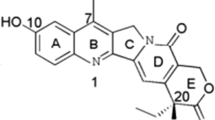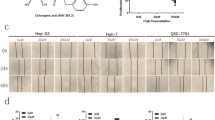Abstract
Hepatocellular carcinoma (HCC) is the third most common cause of cancer-related death in Asia. HCC is less sensitive to chemotherapy and is known to express multidrug resistant genes to acquire resistance to chemotherapeutic agents, therefore the development of a potent HCC suppressor is essential in treating HCC. Our previous reports demonstrated that oligo-fucoidan from the brown seaweed Sargassum hemiphyllum elevates microRNA-29b to inhibit epithelial-mesenchymal transition in hepatoma cells. In this study, we aimed to examine in vitro effect of oligo-fucoidan in hepatocellular carcinoma through apoptosis and long noncoding RNA (lncRNA) pathway. Oligo-fucoidan was studied for its anti-hepatoma cells by MTT and DNA ladder analysis. And the mechanism was studied by flow cytometry, qPCR and western blot analysis. In this study, oligo-fucoidan induced sub-G1 phase cell cycle arrest and activation of caspases, indicating that the intrinsic and extrinsic apoptotic pathways were involved in the mechanism of oligo-fucoidan-induced cell death. Moreover, oligo-fucoidan significantly increased the expression of p53, p21, and p27, while cyclin-B1 and -D1 were decreased at the mRNA and protein levels. Finally, we showed that targeting apoptosis and cell cycle pathways could also contribute to the induction of the lncRNA-Saf and lncRNA-p21. Through human lncRNA profiler array analysis, the differential expression of lncRNAs in HCC cells following oligo-fucoidan exposure was further examined. These findings indicated that lncRNAs switched oligo-fucoidan-induced apoptosis, which might be potentially valuable in HCC adjuvant therapy.





Similar content being viewed by others
References
Billen LP, Shamas-Din A, Andrews DW (2008) Bid: a Bax-like BH3 protein. Oncogene 27:S93–S104
Chen G, Wang Z, Wang D, Qiu C, Liu M, Chen X, Zhang Q, Yan G, Cui Q (2013) LncRNADisease: a database for long-non-coding RNA-associated diseases. Nucleic Acids Res 41:D983–D986
Chen S, Zhao Y, Zhang Y, Zhang D (2014) Fucoidan induces cancer cell apoptosis by modulating the endoplasmic reticulum stress cascades. PLoS ONE 9:e108157
Chen MC, Hsu WL, Hwang PA, Chen YL, Chou TC (2016) Combined administration of fucoidan ameliorates tumor and chemotherapy-induced skeletal muscle atrophy in bladder cancer-bearing mice. Oncotarget 7:51608–51618
Cho ML, Lee BY, You SG (2010) Relationship between oversulfation and conformation of low and high molecular weight fucoidans and evaluation of their in vitro anticancer activity. Molecules 16:291–297
Cho Y, Yoon JH, Yoo JJ, Lee M, Lee DH, Cho EJ, Lee JH, Yu SJ, Kim YJ, Kim CY (2015) Fucoidan protects hepatocytes from apoptosis and inhibits invasion of hepatocellular carcinoma by up-regulating p42/44 MAPK-dependent NDRG-1/CAP43. Acta Pharm Sin B 5:544–553
Ding G, Peng Z, Shang J, Kang Y, Ning H, Mao C (2017) LincRNA-p21 inhibits invasion and metastasis of hepatocellular carcinoma through miR-9/E-cadherin cascade signaling pathway molecular mechanism. Onco Targets Ther 10:3241–3247
Enari M, Sakahira H, Yokoyama H, Okawa K (1998) A caspase-activated DNase that degrades DNA during apoptosis, and its inhibitor ICAD. Nature 391:43–50
Fang L, Sun J, Pan Z, Song Y, Zhong L, Zhang Y, Liu Y, Zheng X, Huang P (2017) Long non-coding RNA NEAT1 promotes hepatocellular carcinoma cell proliferation through the regulation of miR-129-5p-VCP-IκB. Am J Physiol Gastrointest Liver Physiol 313:G150–G156
Fitton JH (2011) Therapies from fucoidan; multifunctional marine polymers. Mar drugs 9:1731–1760
Gomes AQ, Nolasco S, Soares H (2013) Non-coding RNAs: multi-tasking molecules in the cell. Int J Mol Sci 14:16010–16039
Han EKH, Ng SC, Arber N, Begemann M, Weinstein IB (1999) Roles of cyclin D1 and related genes in growth inhibition, senescence and apoptosis. Apoptosis 4:213–219
Hsu HY, Lin TY, Hwang PA, Tseng LM, Chen RH, Tsao SM, Hsu J (2013) Fucoidan induces changes in the epithelial to mesenchymal transition and decreases metastasis by enhancing ubiquitin-dependent TGFβ receptor degradation in breast cancer. Carcinogenesis 34:874–884
Hsu HY, Lin TY, Wu YC, Tsao SM, Hwang PA, Shih YW, Hsu J (2014) Fucoidan inhibition of lung cancer in vivo and in vitro: role of the Smurf2-dependent ubiquitin proteasome pathway in TGFβ receptor degradation. Oncotarget 5:7870–7885
Hung YL, Hwang PA, Wu CH (2010) Evaluation of antioxidative and immune activity of water extracts from three brown seaweeds. J Fish Soc Taiwan 18:95–107
Hwang PA, Chien SY, Chan YL, Lu MK, Wu CH, Kong ZL, Wu CJ (2011) Inhibition of lipopolysaccharide (LPS)-induced inflammatory responses by Sargassum hemiphyllum sulfated polysaccharide extract in RAW 264.7 macrophage cells. J Agric Food Chem 59:2062–2068
Hwang PA, Yan MD, Lin HTV, Li KL, Lin YC (2016) Toxicological evaluation of low molecular weight fucoidan in vitro and in vivo. Mar drugs 14:121–135
Hwang PA, Yan MD, Kuo KL, Phan NN, Lin YC (2017) A mechanism of low molecular weight fucoidans degraded by enzymatic and acidic hydrolysis for the prevention of UVB damage. J Appl Phycol 29:521–529
Kantari C, Walczak H (2011) Caspase-8 and Bid: caught in the act between death receptors and mitochondria. BBA Mol Cell Res 1813:558–563
Kato A, Miyazaki M, Ambiru S, Yoshitomi H, Ito H, Nakagawa K, Shimizu H, Yokosuka O, Nakajima N (2001) Multidrug resistance gene (MDR-1) expression as a useful prognostic factor in patients with human hepatocellular carcinoma after surgical resection. J Surg Oncol 78:110–115
Kew MC (2010) Epidemiology of chronic hepatitis B virus infection, hepatocellular carcinoma, and hepatitis B virus-induced hepatocellular carcinoma. Pathol Biol 58:273–277
Kischkel FC, Hellbardt S, Behrmann I, Germer M, Pawlita M, Krammer PH, Peter ME (1995) Cytotoxicity-dependent APO-1 (Fas/CD95)-associated proteins form a death-inducing signaling complex (DISC) with the receptor. EMBO J 14:5579–5588
Kung JT, Colognori D, Lee JT (2013) Long noncoding RNAs: past, present, and future. Genetics 193:651–669
Lazebnik YA, Kaufmann SH, Desnoyers S, Poirier G, Earnshaw W (1994) Cleavage of poly (ADP-ribose) polymerase by a proteinase with properties like ICE. Nature 371:346–347
Li SP, Xu HX, Yu Y, He JD, Wang Z, Xu YJ, Wang CY, Zhang HM, Zhang RX, Zhang JJ, Yao Z, Shen ZY (2016) LncRNA HULC enhances epithelial-mesenchymal transition to promote tumorigenesis and metastasis of hepatocellular carcinoma via the miR-200a-3p/ZEB1 signaling pathway. Oncotarget 7:42431–42446
Macleod KF, Sherry N, Hannon G, Beach D, Tokino T, Kinzler K, Vogelstein B, Jacks T (1995) p53-dependent and independent expression of p21 during cell growth, differentiation, and DNA damage. Genes Dev 9:935–944
Min EY, Kim IH, Lee J, Kim EY, Choi YH, Nam TJ (2014) The effects of fucodian on senescence are controlled by the p16INK4a-pRb and p14Arf-p53 pathways in hepatocellular carcinoma and hepatic cell lines. Int J Oncol 45:47–56
Naeini MM, Ardekani AM (2009) Noncoding RNAs and cancer. Avicenna J Med Biotechnol 1:55–70
Nagasue N, Uchida M, Makino Y, Takemoto Y, Yamanoi A, Hayashi T, Chang YC, Kohno H, Nakamura T, Yukaya H (1993) Incidence and factors associated with intrahepatic recurrence following resection of hepatocellular carcinoma. Gastroenterology 105:488–494
Nigam N, Prasad S, George J, Shukla Y (2009) Lupeol induces p53 and cyclin-B-mediated G2/M arrest and targets apoptosis through activation of caspase in mouse skin. Biochem Biophys Res Commun 381:253–258
Park HY, Kim GY, Moon SK, Kim WJ, Yoo YH, Choi YH (2014) Fucoidan inhibits the proliferation of human urinary bladder cancer T24 cells by blocking cell cycle progression and inducing apoptosis. Molecules 19:5981–5998
Park HY, Park SH, Jeong JW, Yoon D, Han MH, Lee DS, Choi G, Yim MJ, Lee JM, Kim DH (2017) Induction of p53-independent apoptosis and G1 cell cycle arrest by fucoidan in HCT116 human colorectal carcinoma cells. Mar Drugs 15:154
Phuah NH, Nagoor NH (2014) Regulation of microRNAs by natural agents: new strategies in cancer therapies. Biomed Res Int 2014:804510
Sehgal L, Mathur R, Braun FK, Wise JF, Berkova Z, Neelapu S, Kwak LW, Samaniego F (2014) FAS-antisense 1 lncRNA and production of soluble versus membrane Fas in B-cell lymphoma. Leukemia 28:2376–2387
Tang SS, Zheng BY, Xiong XD (2015) LincRNA-p21: implications in human diseases. Int J Mol Sci 16:18732–18740
Tran UM, Rajarajacholan U, Soh J, Kim TS, Thalappilly S, Sensen CW, Riabowol K (2015) LincRNA-p21 acts as a mediator of ING1b-induced apoptosis. Cell Death Dis 6:e1668
Villamizar O, Chambers CB, Riberdy JM, Persons DA, Wilber A (2016) Long noncoding RNA Saf and splicing factor 45 increase soluble Fas and resistance to apoptosis. Oncotarget 7:13810–13826
Wang Y, Chen F, Zhao M, Yang Z, Li J, Zhang S, Zhang W, Ye L, Zhang X (2017) The long noncoding RNA HULC promotes liver cancer by increasing the expression of the HMGA2 oncogene via sequestration of the microRNA-186. J Biol Chem 292:15395–15407
Xiong Y, Fang JH, Yun JP, Yang J, Zhang Y, Jia WH, Zhuang SM (2010) Effects of microRNA-29 on apoptosis, tumorigenicity, and prognosis of hepatocellular carcinoma. Hepatology 51:836–845
Yan MD, Hong CC, Lai GM, Cheng AL, Lin YW, Chuang SE (2005) Identification and characterization of a novel gene Saf transcribed from the opposite strand of Fas. Hum Mol Genet 14:1465–1474
Yan MD, Yao CJ, Chow JM, Chang CL, Hwang PA, Chuang SE, Jacqueline WP, Lai GM (2015) Fucoidan elevates microRNA-29b to regulate DNMT3B-MTSS1 axis and inhibit EMT in human hepatocellular carcinoma cells. Mar Drugs 13:6099–6116
Yang L, Wang P, Wang H, Li Q, Teng H, Liu Z, Yang W, Hou L, Zou X (2013) Fucoidan derived from Undaria pinnatifida induces apoptosis in human hepatocellular carcinoma SMMC-7721 cells via the ROS-mediated mitochondrial pathway. Mar Drugs 11:1961–1976
Yu FJ, Zheng JJ, Dong PH, Fan XM (2015) Long non-coding RNAs and hepatocellular carcinoma. Mol Clin Oncol 3:13–17
Acknowledgements
Funding was provided by Ministry of Science and Technology, Taiwan (No. 106-2320-B-019-001).
Author information
Authors and Affiliations
Corresponding author
Ethics declarations
Conflict of interest
Authors declare no conflict of interest in this manuscript.
Additional information
Publisher's Note
Springer Nature remains neutral with regard to jurisdictional claims in published maps and institutional affiliations.
Rights and permissions
About this article
Cite this article
Yan, MD., Lin, HY. & Hwang, PA. The anti-tumor activity of brown seaweed oligo-fucoidan via lncRNA expression modulation in HepG2 cells. Cytotechnology 71, 363–374 (2019). https://doi.org/10.1007/s10616-019-00293-7
Received:
Accepted:
Published:
Issue Date:
DOI: https://doi.org/10.1007/s10616-019-00293-7




